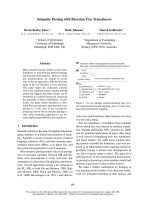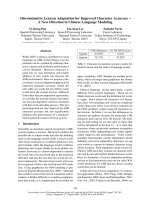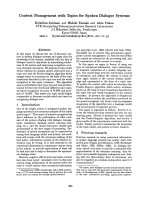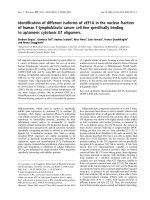Báo cáo khoa học: Alcoholic fermentation with different initial glucose concentration using immobilized yeast in calcium alginate gel pptx
Bạn đang xem bản rút gọn của tài liệu. Xem và tải ngay bản đầy đủ của tài liệu tại đây (396.01 KB, 7 trang )
TẠP CHÍ PHÁT TRIỂN KH&CN, TẬP 11, SỐ 12 - 2008
Bản quyền thuộc ĐHQG-HCM Trang 61
ALCOHOLIC FERMENTATION WITH DIFFERENT INITIAL GLUCOSE
CONCENTRATION USING IMMOBILIZED YEAST IN CALCIUM
ALGINATE GEL
Bui Thanh Huyen, Le Van Viet Man
University of Technology, VNU-HCM
(Manuscript Received on March 27
th
, 2006, Manuscript Revised Septemberl 03
rd
, 2008)
ABSTRACT: In this research, the growth and metabolic activities of Saccharomyces
cerevisiae immobilized in alginate gel during alcoholic fermentation with different initial
glucose concentration were studied. Starting from initial glucose concentration at 140 g/L, we
observed that increasing this concentration to 220 g/L had little effect on the growth of
immobilized yeast. Under the same conditions, the maximum biomass, glucose uptake rate,
and final ethanol concentration obtained in the immobilized yeast cultures were always higher
than those in the free yeast cultures. In 220 g glucose/L medium, the final ethanol
concentration produced by immobilized yeast was very high (about 10.4-11.7% v/v). It can be
concluded that immobilized yeast were less sensitive to high osmotic pressure and high
ethanol concentration in medium than free yeast. Therefore, using immobilized yeast in
alcoholic fermentation is potential to enhance ethanol productivity.
1.INTRODUCTION
Ethanol has many uses in industry as well as in daily life. It is raw material in liquor
production, a popular solvent in many industries and gradually becomes a popular
environment friendly fuel. The development of the ethanol industry led to the demand for
effective fermentation technique to improve ethanol yield.
Nowadays, all Vietnamese ethanol factories carry out the alcoholic fermentation in
medium with initial substrate concentration 150 g/L. High gravity fermentation technology
allows production of higher ethanol concentration without changing plant size. However, in
the culture with high initial substrate concentration, yeast growth and metabolic activities were
significantly inhibited due to the high osmotic pressure and high content of final products
(including ethanol and other by-products) [1,3,12].
Optimistically, these disadvantages can be lessened by using immobilized yeast. It has
been reported that immobilized yeast was less sensitive to the difficult fermentation conditions
such as high temperature, low pH and high concentration of inhibitors [4,6,11]. Moreover,
immobilized cells can be used for continuous fermentation or reused for many batch cycles
[9]. Therefore, the combination of yeast immobilization and high gravity fermentation
technology will be a good solution to ameliorate the ethanol production.
Among many cell immobilization methods with different carriers, cell entrapment in
alginate gel is a popular method because of the simple immobilization procedure, the high cell
density in the gel [7] and the non-toxic carrier [8].
In this research, the growth and metabolic activities of Saccharomyces cerevisiae
immobilized in alginate gel during alcoholic fermentation with different initial glucose
concentration were studied.
Science & Technology Development, Vol 11, No.12 - 2008
Trang 62 Bản quyền thuộc ĐHQG-HCM
2.MATERIALS AND METHODS
2.1.Microorganism
A strain of Saccharomyces cerevisiae species from the collection of Microbiological
Laboratory, Department of Food Technology, Ho Chi Minh City University of Technology
was used.
2.2.Procedure of yeast immobilization
- Incubate Saccharomyces cerevisiae in shaken flasks at 30°C for 24 hours.
- Collect yeast cells by centrifugation (4°C, 6000 rpm, 15 min).
- Make a yeast suspension in sterilized water in which the cell concentration was 50×10
6
cells/mL.
- Mix this yeast suspension with an equal volume (1:1, v/v) of 30 g/L sodium alginate
(Sigma, A-7128) solution.
- Extrude the mixture drop by drop by a syringe into 20 g/L CaCl
2
solution.
Gel formation was instantaneous but as far as gel hardening, the formed beads were
immersed in the stirred CaCl
2
solution (using a magnetic stirrer) for at least 2 hours. The
immobilization was carried out at ambient temperature. Each mL of alginate-yeast cell
suspension formed 10 beads. The number of viable yeast cells in beads was about 25×10
6
cells/cm
3
beads. Diameter of beads ranged from 2.0 to 3.0 mm after immobilization. It was
supposed that the bead diameter does not change during the fermentation.
After hardening, beads were washed by sterilized water to remove excess calcium ions.
They were immediately used for experiments after entrapment.
Medium proposed by Strehaiano et al.[13] was used for yeast propagation and alcoholic
fermentation. The composition of this medium was as follows (g/L): D-glucose – 150 to 250;
(NH
4
)
2
SO
4
- 2; KH
2
PO
4
- 5; MgSO
4
.7H
2
O - 0.4; yeast extract - 1. The pH of the medium was
4.5.
Alginate solution, CaCl
2
solution and water used in the immobilization and culture
medium were sterilized at 121°C for 15 minutes.
2.3.Alcoholic fermentation
Batch fermentation by immobilized yeast was carried out at 30
o
C, pH 4.5. The inoculating
rate was 5×10
6
viable cells/mL. Immobilized yeast cells were used for 2 fermentation cycles (I,
II). At the end of the first cycle, beads were separated from the culture and immersed in a 20
g/L CaCl
2
solution for 15 minutes for gel hardening. Then, they were washed by sterilized
water and inoculated in the fresh medium. Fermentation was considered as completed if the
decrease of glucose concentration in the culture was less than 1 g/L during 6 successive hours.
Control samples with free cells were carried out in the same fermentation conditions.
However, free cells were used for only one fermentation cycle.
2.4.Analytical methods
The yeast growth in immobilized yeast cultures was examined by 3 parameters: Yeast cell
concentration within gel beads, yeast cell concentration outside beads, and yeast cell
concentration in the whole culture, which were determined and calculated as described else
where [5].
Yeast cell concentration was quantified by haemocytometry method, using a Thoma
counting chamber. Dead cell concentration was determined by the methylene blue method [4].
TẠP CHÍ PHÁT TRIỂN KH&CN, TẬP 11, SỐ 12 - 2008
Bản quyền thuộc ĐHQG-HCM Trang 63
Glucose concentration was quantified by a spectrophotometric method, using 3,5-
dinitrosalycylic acid reagent [10]. Ethanol concentration was determined by a method based on
distillation and density quantification [2].
2.5.Formulas
t
GG
R
fi
G
][][ −
=
, where R
G
(g/h.L) is the glucose uptake rate, [G]
i
(g/L) is the initial
glucose concentration in the culture, [G]
f
(g/L) is the final glucose concentration in the culture,
and t (h) is the fermentation time.
3.RESULTS AND DISCUSSION
3.1.Immobilized yeast growth in media with different initial glucose concentration
The growth of yeast in the immobilized cell cultures and free cell cultures with different
initial glucose concentrations 140 g/L, 170 g/L, and 220 g/L are presented in Figure 1a, 1b, 1c
respectively.
In general, the growth rate of immobilized yeast in cycle II was lower than that in cycle I.
There may be 2 reasons for that.
Firstly, at the end of cycle I, immobilized yeast was in stress due to high ethanol
concentration and low pH. So in cycle II, it took the yeast longer time to overcome the stress,
adapt to new culture and continue budding.
Secondly, during the fermentation, the beads became porous because of the growth of
yeast and the release of CO
2
. Therefore, the immobilized yeast was more exposed to high
osmotic pressure in cycle II than in cycle I.
However, the yeast growth rate and maximum biomass obtained in the immobilized cell
cultures always higher than those obtained in the free cell cultures. Maybe, during the
fermentation with high initial glucose contents using immobilized yeast, gradients of glucose
concentration were formed through the gel beads. It helped the cell gradually get familiar with
high osmotic pressure.
0.0
10.0
20.0
30.0
40.0
50.0
60.0
70.0
80.0
90.0
0 1020304050607080
Time (hour)
Cell concentration
(million cells/mL culture)
0.0
10.0
20.0
30.0
40.0
50.0
60.0
70.0
80.0
90.0
0 20406080100120140160
Time (
h
Cell concentration
(million cells/mL culture)
(a) (b)
Science & Technology Development, Vol 11, No.12 - 2008
Trang 64 Bản quyền thuộc ĐHQG-HCM
0.0
10.0
20.0
30.0
40.0
50.0
60.0
70.0
80.0
90.0
0 20 40 60 80 100 120 140 160
Time (h
o
Cell concentration
(million cells/mL culture)
Fig. 1. Growth of yeast in immobilized yeast
culture cycle I (¡ - Total cells, - Dead
cell), cycle II (z- Total cells, { - Dead cell)
and free yeast culture (S - Total cells, U -
Dead cell) during the fermentation at 30°C,
initial pH 4.5 and initial glucose
concentration 140 g/L (a), 170 g/L (b) and
220 g/L (c).
* Total cells included viable cells and dead
cells.
(c)
3.2.Metabolic activities of immobilized yeast cultured with different initial glucose
concentration
The influence of initial glucose concentration on metabolic activities of yeast was
evaluated by the overall glucose uptake rate and final ethanol concentration (Table 1). The
changes of glucose concentration during the fermentations were shown on Figure 2.
In the immobilized cell cultures, cycle II was usually longer than cycle I and the increase
in initial glucose concentration led to in the increase in fermentation time. Besides, when the
initial glucose content increased, the glucose uptake rate decreased. However, the changes in
the immobilized cell cultures were not as significant as in the free cell cultures.
In comparison with the free cell cultures, the immobilized cell cultures always lasted
longer but the residual glucose concentrations were much lower. In addition, the final ethanol
concentrations obtained by immobilized cells were about 8.4 – 11.7 %v/v, which were twice as
high as those obtained by free yeast in the similar conditions. Probably, the immobilized cells
were protected from the undesirable changes of the culture during the fermentation (the
decrease of pH and the accumulation of ethanol). These changes might cause the diminution in
metabolic activities of the free cells.
0.0
50.0
100.0
150.0
200.0
250.0
0 1020304050607080
Time (hour)
Glucose concentration (g/L)
0.0
50.0
100.0
150.0
200.0
250.0
0 20 40 60 80 100 120 140 160 180
Time (hour)
Glucose concentration (g/L)
(a) (b)
TẠP CHÍ PHÁT TRIỂN KH&CN, TẬP 11, SỐ 12 - 2008
Bản quyền thuộc ĐHQG-HCM Trang 65
0.0
50.0
100.0
150.0
200.0
250.0
0 20 40 60 80 100 120 140 160 180
Time
(
hour
)
Glucose concentration (g/L)
Fig. 2. Kinetics of glucose content in the
immobilized cell culture cycle I (¡), cycle II (z)
and free cell culture (S) at 30°C, initial pH 4.5
and initial glucose concentration 140 g/L (a), 170
g/L (b) and 220 g/L (c)
.
(c)
Table 1. Characteristics of alcoholic fermentation by immobilized and free cells at different
initial glucose concentrations (140, 170, and 220 g/L).
Characteristic
Glucose uptake rate
(g/L.h)
Final ethanol concentration
(%v/v)
Initial glucose concentrations
(g/L)
140 170 220 140 170 220
Immobilized yeast - Cycle I 1.93 1.83 1.90 8.4 10.4 11.7
Immobilized yeast - Cycle II 2.04 1.19 1.09 8.6 10.4 10.4
Free yeast 1.43 0.72 0.98 4.7 4.7 5.6
3.CONCLUSION
The obtained result in this study confirmed the protective effect of alginate carrier on yeast
cells during alcoholic fermentation. Therefore, immobilized yeast was more resistant to high
osmotic pressure, low pH media and high ethanol concentration. Those characteristics made it
possible to obtain high ethanol concentration in the culture with high initial glucose
concentration. In conclusion, using immobilized yeast in alcoholic fermentation is potential to
enhance ethanol productivity without significant changes in the plant size.
Science & Technology Development, Vol 11, No.12 - 2008
Trang 66 Bản quyền thuộc ĐHQG-HCM
LÊN MEN CỒN BẰNG NẤM MEN CỐ ĐỊNH TRONG TRONG CÁC MÔI
TRƯỜNG CÓ NỒNG ĐỘ GLUCOSE BAN ĐẦU KHÁC NHAU
Bùi Thanh Huyền, Lê Văn Việt Mẫn
Trường Đại học Bách Khoa, ĐHQG-HCM
TÓM TẮT: Trong nghiên cứu này, chúng tôi khảo sát sự sinh trưởng và hoạt tính của
nấm men Saccharomyces cerevisiae cố định trong gel alginate trong quá trình lên men cồn với
nồng độ glucose ban đầu của môi trường tăng dần. Khi tăng nồng độ glucose ban đầu từ 140
g/L lên 200 g/L, chúng tôi nhận thấy sự thay đổi nồng độ glucose không ảnh hưởng đáng kể
đến sự sinh trưởng cũng như ho
ạt tính của nấm men cố định. Trong cùng điều kiện thí nghiệm,
quá trình lên men bằng nấm men cố định luôn cho lượng sinh khối cực đại, tốc độ lên men và
nồng độ cồn cuối cao hơn quá trình lên men với nấm men tự do. Trong môi trường có nồng độ
glucose ban đầu là 220 g/L, nấm men cố định tạo được nồng độ cồn cuối rất cao (khoảng
10.4-11.7% v/v). Có thể kết luận rằng nấm men cố đị
nh trong gel alginate ít mẫn cảm với áp
suất thẩm thấu cũng như nồng độ cồn cao của môi trường. Vì vậy, sử dụng nấm men cố định
trong sản xuất cồn từ môi trường có nồng độ chất khô ban đầu cao là một phương pháp hiệu
quả để nâng cao sản lượng cồn.
REFERENCES
[1]. Almeida RB., Alameida e Silva JB., Lima UA., Silva DP.,
Assis AN., Evaluation of
fermentation parameters during high-gravity beer production, Braz. J. Chem.
Eng., 18 (4): 459-465 (2001)
[2]. AOAC, Official Methods of Analysis of AOAC International, 15
th
edition, Maryland,
AOAC International, (1990)
[3]. Arrizon J., Gschaedler A., Increasing fermentation efficiency at high sugar
concentrations by supplementing an additional source of nitrogen during the
exponential phase of the tequila fermentation process, Can. J. Microbiol., 48: 965-
970 (2002)
[4]. ASBC, Methods of analysis, 8
th
edition, Minnesota: The American Society of Beer
Chemists (1992)
[5]. Bui TH., Le Van VM., Growth and metabolic activities of immobilized yeast cells in
clcium alginate gel during alcoholic fermentation, Proceedings of Regional
Symposium on Chemical Engineering 2005, 1: 153-157 (2005)
[6]. Desimone MF., D’Aquino M., Diaz LE., Ethanol tolerance in free and sol-gel
immobilized Saccharomyces cerevisiae, Biotechnol. Lett., 24 (19): 1557-1559 (2002)
[7]. Dömény Z, Šmogrovičová D, Gemeiner P, Šturdík E, Pátková J, Malovíková A,
Continuous secondary fermentation using immobilized yeast, Biotechnol. Lett., 20:
1041-1045, (1998)
[8]. Göksungur Y, Zorlu N, Production of ethanol from beet molasses by Ca-alginate
immobilized yeast cells in a packed-bed bioreactor, Turk. J. Biol., 25: 265-275
(2001)
[9]. Klein J., Kressdort B., Polymers for the immobilization of whole cells and their
application in biotechnology, Angew. Makromol. Chem., 166: 293-309 (1989)
TẠP CHÍ PHÁT TRIỂN KH&CN, TẬP 11, SỐ 12 - 2008
Bản quyền thuộc ĐHQG-HCM Trang 67
[10]. Miller GL., Use of dinitrosalicylic acid reagent for determination of reducing sugar,
Anal. Chem., 3: 426-428 (1959)
[11]. Norton S., Watson K., D’Amore T., Ethanol tolerance of immobilized brewers’ yeast
cells, Appl. Microbiol. Biotechnol, 43 (1): 18-24 (1995)
[12]. Oliveira C., Rosa MF., Cabral JMS., Aires-Barros RM., Effect of extraction and
enzymatic esterification of ethanol on glucose consumption by two Saccharomyces
cerevisiae strains: a comparative study, J. Chem. Technol. Biotechnol., 76: 285-290
(2001)
[13]. Strehaiano P., Mota M., Goma G., Effect of inoculum level on kinetics of alcoholic
fermentation, Biotechnol. Lett., 5: 135-140 (1983)









